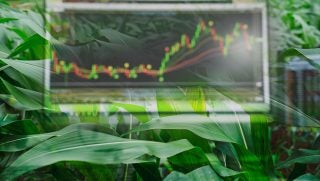Many industries have adopted the digital twin real-time data analysis, yet experts are still exploring how this machine-learning technology will improve agriculture.
Across a number of industries, the concept of using “digital twins” is being hyped as a modern and high-tech way to revolutionize work flows and increase competitive advantage — something agricultural sectors are always on the lookout for. But how does the digital twin model work in agriculture? Do farmers and ranchers have the same opportunities to benefit from this technology as other businesses?
First, we recognize that this is a very new term and doesn’t have a lot of reach outside of corporate and tech culture. So let’s define “digital twin.” According to IBM, “A digital twin is a virtual representation of an object or system designed to reflect a physical object accurately. It spans the object’s lifecycle, is updated from real-time data and uses simulation, machine learning and reasoning to help make decisions.”
According to Global Ag Tech, it’s kind of like SimCity, that digital game from the ’90s.
But that comparison isn’t perfect because a digital twin isn’t really a simulation, although it utilizes digital models to replicate products and processes similarly. Digital twins are more versatile and provide a deeper projective process. More specifically, a digital twin is designed to build a “virtual environment able to study several simulations, backed up with real-time data and a two-way flow of information between the twin and the sensors that collect this data, according to engineering consulting firm TWI. The key differences are:
- “Static vs. Active: A CAD-based simulation models a product or process into which different parameters or design elements can be introduced and tested. This type of model is static as it won’t change or develop unless a designer introduces more elements. However, while a digital twin will begin much the same as a simulation model, the introduction of real-time data means that the twin can change and develop to provide a more active simulation. A digital twin can mature through a product lifecycle as more data is collected and analyzed, offering different information that is not available with a static simulation.”
- “Possible vs. Actual: A simulation replicates what could happen to a product, but a digital twin replicates what is happening to an actual specific product in the real world. Any changes to a simulation are limited to the imagination of a designer who needs to input any changes. However, because a digital twin offers real feedback, the designer can see if it is working as intended and then determine any improvements based on actual use. This translates from assets to other applications, such as for a manufacturing process, which can be assessed with real data to react to changing demands, requirements or business conditions. The difference is that while a simulation is theoretical, a digital twin is specific and actual.”
- “Scope of Use: The final key difference is the scope of use that is offered by simulations vs digital twins. A CAD-based simulation allows designers to test different scenarios against set parameters, making it useful for product design purposes. However, the scope of a digital twin reaches much further to include all stages of a product’s lifecycle and meaning that the uses are only limited to the data when matched against areas of the business workflow. This increased scope means that digital twin can find uses outside of design and can help improve processes and make wider business decisions.”
A digital twin is essentially a virtual model of an already existing physical object, that is fitted with sensors, which produce data about that specific object’s performance. The sensors’ data is then applied to the digital model to run simulations in real-time, allowing for improvements to be applied back to the actual physical object.
It does have capabilities within non-physical items, such as processes and systems, and acts as a mirror to mimic the process or system to allow simulations to be run in the same way as a physical item. It collects data from the Internet of Things (IoT) enabled devices (think vehicles, appliances, and other objects embedded with sensors, software, network connectivity which enables them to collect and share data), which then allows digital twins the ability to capture high-level information used to integrate into the virtual model.
With an increase in demand for the agriculture industry to utilize modern technologies, digital twins provide an opportunity for even more precision farming.
ACS Publications published a study discussing the possibilities of digital twin technology in agriculture using a virtual replication of a crop, including development aspects such as irrigation, fertilization, and pest management, in order to optimize sustainability, direct water, and other input savings in what the academic world calls a fourth agricultural revolution, Agriculture 4.0.

In agriculture, digital twins are used to simulate and refine farming methods, within the safety net of virtual settings.
In the study, there are “interaction levels” which include life cycle stages:
(1) An edaphic level, where the soil structure, combined with proper irrigation and fertilization, can be simulated to prevent alterations in agricultural land using IoT real-time data and simulate effects for informed decision-making.
(2) A phytotechnologic level, where labors, fertilizer dosages, and managing costs such as fuel can be improved efficiently and sustainably.
(3) A postharvest level, where the DT can simulate food-related processes such as drying, cooling, transport, and storage degradation.
(4) A farm infrastructure level where levels 1 to 3 are integrated and the DT replicates physical structures on a farm, such as fields, buildings, and equipment, in a virtual environment. This enables farmers to visualize their entire operation digitally.
These levels then require specific modeling functions and subsequent support from its digital twin:
(1) Crop modeling: DTs simulate the growth and development of crops based on various parameters like weather conditions, soil quality, and agricultural practices. This helps in predicting crop yields, identifying potential issues, and optimizing cultivation strategies.
(2) Precision agriculture support: DTs play a crucial role in precision agriculture by providing real-time data on soil conditions, moisture levels, and crop health. This allows farmers or AI to make informed decisions about irrigation, fertilization, and pest control, leading to more efficient resource utilization.
(3) IoT integration: IoT devices, such as sensors and drones, can be integrated with DTs to continuously collect data from the physical environment. This real-time data helps to keep the digital twin updated and facilitates better decision-making.
(4) Climate and weather modeling: DTs can incorporate weather and climate data to simulate how different conditions might affect crops. This helps farmers to plan for potential challenges, such as extreme weather events or changes in temperature and precipitation.
(5) Supply chain optimization: DTs can be extended to model the entire agricultural supply chain, including storage, transportation, and distribution. This allows for better coordination and optimization of the entire food preservation and distribution process.
(6) Decision support systems: By integrating AI and ML algorithms, DTs can provide actionable insights and recommendations; i.e., they can suggest optimal planting times, identify areas requiring additional irrigation, or recommend specific crop varieties based on environmental conditions.
(7) Monitoring and predictive maintenance: DTs can be applied to agricultural machinery and equipment, enabling predictive maintenance, before a breakdown occurs, reducing downtime, and improving overall efficiency.
(8) Data-driven farm management: The data generated and analyzed by DTs contribute to data-driven M2M farm management. Farmers can track historical performance, assess trends, and make strategic decisions to improve productivity and sustainability. In this review, the structure and data flow on different DT integration in agriculture along the lifecycle is overviewed focusing on production.

The study does discuss that, while digital twins are commonly used to prevent system failures, the kind used for agriculture tend to lean more into the climate change conversation. Through optimizing scarce natural resources, reducing the impact of extreme weather events, and managing effects of various stressors on crops, digital twins propose preventive actions that can impact a crop and the supply chain.
This includes:
- Soil preservation, which a digital twin can aide in assessing soil properties, so that nutrients, fertilization, irrigation, and hydric equilibrium can be planned accordingly to prevent soil degradation.
- Crop development, where a digital twin can mirror a growing plant, replicating it’s behavior and biomass development. This allows for more informed planting, irrigation and harvesting processes.
- Climate adaptability, where real-time data from a digital twin can predict a crop’s response to it’s climate and improve resiliency.
- Agronomic machinery, during which every operation has machinery that has downtime due to various malfunctions. A digital twin would increase efficiency and allow for tests to be done without compromising real equipment, which can improve machinery use overall. Farmers can manage operations remotely, without the need to directly observe tasks or machinery on-site. Using a digital twin allows farmers to simulate the effects of any interventions based on real-life data, instead of having to go out to the field.
According to Global Ag Tech, digital twin technology may not be necessary, as there are so many advances in machine learning that can already predict key events, without the expense that digital twins comes with, for example, the article states:
“If you grow potatoes it is important to have indicators for pests such as late blight disease, caused by a fungus-like organism that can result in crop failures in a short period if appropriate control measures are not adopted,” wrote Raviv Itzhaky, CTO of Prospera Technologies. “For this type of row crop on large acres of open field, having cameras mounted on pivot irrigation systems can efficiently and effectively identify diseases or issues. The data needed to create a digital twin for an open field of potatoes would cost a fortune, and creating an entire model at such a scale to get insights that can be obtained with simpler and more affordable technology, just doesn’t make sense.
“There are specific use cases where it makes financial sense to build a digital twin, such as for plant breeding, where a model could allow you to predict early on if a specific variety is not commercially viable. But in many cases, there’s no need to crack a nut with a sledgehammer.”
There is also risk of private data being collected that would need to be protected within a digital twin system and the amount of devices, sensors, and actuators needed to build a digital twin can lead to electronic waste generation, as well as cost a small fortune to build initially.
The agriculture industry is already advancing greatly through the use of modern technology, and there are better ways to calculate risk than the industry had access to decades ago, but with a large amount of industrial companies using digital twins currently, leading to more effectiveness for those businesses, will agriculture fall behind if it doesn’t capitalize on this technology?
Markie Hageman Jones majored in agribusiness at Fort Hays State University. She is actively involved in her state Cattlemen’s Association, Young Farmers chapter, and National Cattlemen’s Beef Association. Her AGDAILY.com articles can be found here.



